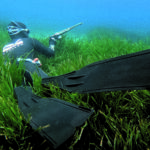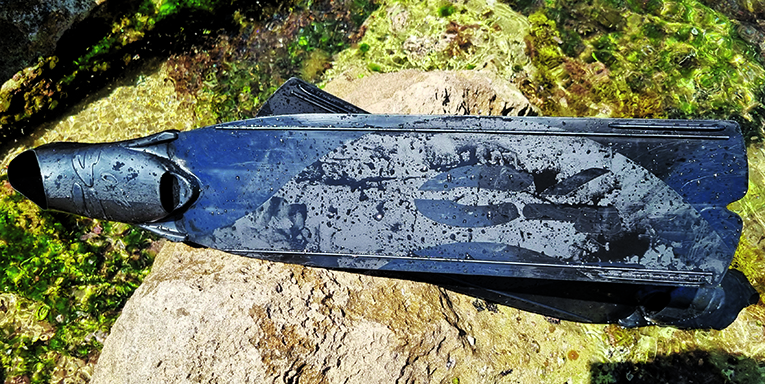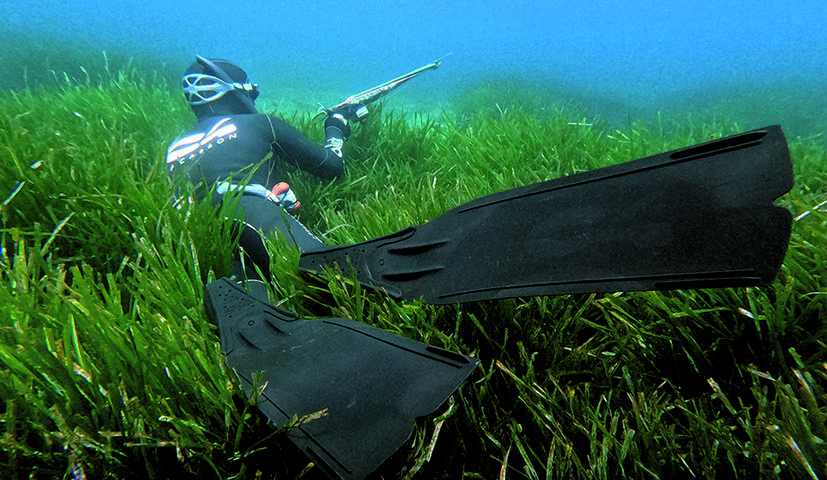C4: Predator Fins

C4: Predator Fins
22 July 2024
DOUBLE VICTORY FOR VINCENZO FERRI
31 July 2024The so-called "battle plastic" that incorporates all the latest innovations on the market. A perfect model for the novice but also interesting for the expert looking for a no-compromise solution
Jack Cubeddu
Alongside the release of the new Storm fins, tested for you a few months ago, C4 Carbon offers another technopolymer solution. A versatile product that meets the demand for a standard-length, economical fin suitable for both novices and those looking for a straightforward model. Thus, the Predator is born.
Unlike its sister fin, the Storm, the Predator has a standard overall length, with a blade length of 87 centimeters (compared to the Storm's 78 cm). In the Predator, the foot pocket (we're talking about the 250) is overmolded onto the blade, making the fin a single piece, non-detachable. This operation reduces production costs and consequently the final product cost, without sacrificing quality.
A "battle plastic" made by selecting a lightweight technopolymer with a quick response, visible even in a simple hand bend. The mechanical part of the blade has been designed and structured with two small ribs at the edges, visible on both sides, which help ensure elasticity and return during the thrust phases, aided by two shorter and thicker ribs located underneath, in front of the foot.
Another feature is the black water rails applied to the final part, which ensure movement stability, avoiding the drifting effect.
Now, let's analyze the design. The blade features graphics with a wavy effect, with shiny/matte plays, creating a nice contrast, with the C4 logo on the front and back in a shiny effect, standing out from the rest of the context.
The 250 foot pocket completes the fin, to which we have dedicated several lines in many of our tests, but which also deserves a mention here. Besides the well-known comfort, it allows the blade to behave naturally, without any influence from the side rails, which are almost entirely absent.
Another noteworthy feature is the weight. Thanks to the lightness of the 250 foot pocket combined with the quality of the blade's polymer, the fin weighs just 630 grams (in the tested size 42/43).
The new Predator is available in sizes ranging from 36/37 to 44/45, with a retail price of €70.
At Sea
Taking advantage of the Storm fins test and inviting sea conditions, I decided to take the new Predator fins into the water on the same day, allowing for a comparison and to offer advice to those undecided between the two.
As always, we start with putting on the fins. The practicality of the foot pocket makes everything simple, allowing me to put on the fin quickly even in a rubber dinghy.
Once in the water, I immediately noticed that the sensation is quite different from that experienced with the Storm fins. The leg, accustomed to a smaller blade draft and less effort in thrust, finds a greater contrast with the Predator, which, channeling more water over their surface, requires more effort, consequently generating greater thrust.
To put it practically, to reach the desired spot starting from the same point, I struggle more but need fewer kicks to cover the same distance compared to the Storm.
I arrive at a stretch of Posidonia meadows, interspersed with isolated rocks that allow me to try some ambush and approach techniques in a range between five and eight, nine meters.
The thrust during the descent phases is energetic and vigorous for a simple polymer. During ascent, it ensures a good lift off the bottom, without too much concern about where and how you hit the ground. The undeniable advantage of the technopolymer!
Even in the ten to fifteen-meter range, the fin easily meets expectations, allowing me to perform dives with a good effort/thrust ratio both in descent and ascent.
In movements, it is worth noting how well the 250 foot pocket performs, creating a perfect feeling between foot and fin and, especially thanks to its inclination with the blade, keeping the ankle in a natural position without additional stress.
But let's move to very shallow water, where the Storm played at home. Even with the backrest, the Predator handles well, not showing a particular gap with the other model. The only point to mention is a slight buoyancy or a more pronounced movement during wave phases, requiring more control in positioning the fin on the bottom.
For the rest, I found it easy to manage even in shallow water, allowing quick and smooth movements.
We are now at the end of our outing, and the feet could go on for hours... The comfort of the 250 is truly incredible (provided you choose the correct size), all combined with excellent energy transmission. Truly a great foot pocket!
After several hours wearing only technopolymer blades, our legs start to feel the workload. The advantage and the now common use of carbon, which has become part of any range, both economical and high-end, is undeniable. But it is still worth noting that the simplicity of the new generation technopolymer has satisfied all our fishing needs, both in shallow and mid-depths, albeit with a higher muscular effort.
I find the new Predator to be an everyday fin. Useful for a novice taking their first steps but also for a "Pro" looking for a simple model to handle in shallow waters from the shore; to keep in the boat for an impromptu fishing trip during a few free hours or simply for a snorkeling session on vacation with the family.
Regarding the choice between the two C4 models (Predator and Storm), I would say that they are very similar, although there are conditions to consider before a possible purchase.
First, our weight. If we have a fairly substantial physical build, combined with the kilograms of the ballast, it is better to opt for the Predator, which has a greater draft and consequently greater thrust.
The technique to be used is also important for the choice. It is ideal to opt for the Storm if fishing in very shallow water or foam, with the possibility of some dives in the medium range, while I find the Predator more suitable if you intend to stay in a mid/low range, with some excursions in very shallow water.
Scores
Structure: 7.5 Well made through several ribs that allow, even through the chosen polymer, a quick response. Completed by the small water rails.
Materials: 8 A simple but high-performance technopolymer. Lightness and reactivity first and foremost!
Comfort: 8 The 250 foot pocket provides an excellent feeling of comfort, preventing ankle fatigue despite the blade's robustness.
Performance:7 Offers thrust within the average for polymers, but with the advantage of rare lightness on the feet.
Design: 8 Beautiful glossy/matte plays, simple but scenic, allowing for a great contrast with the C4 logo.
Value for Money: 10 As with the Storm, it is undoubtedly one of the strengths of the Predator.



